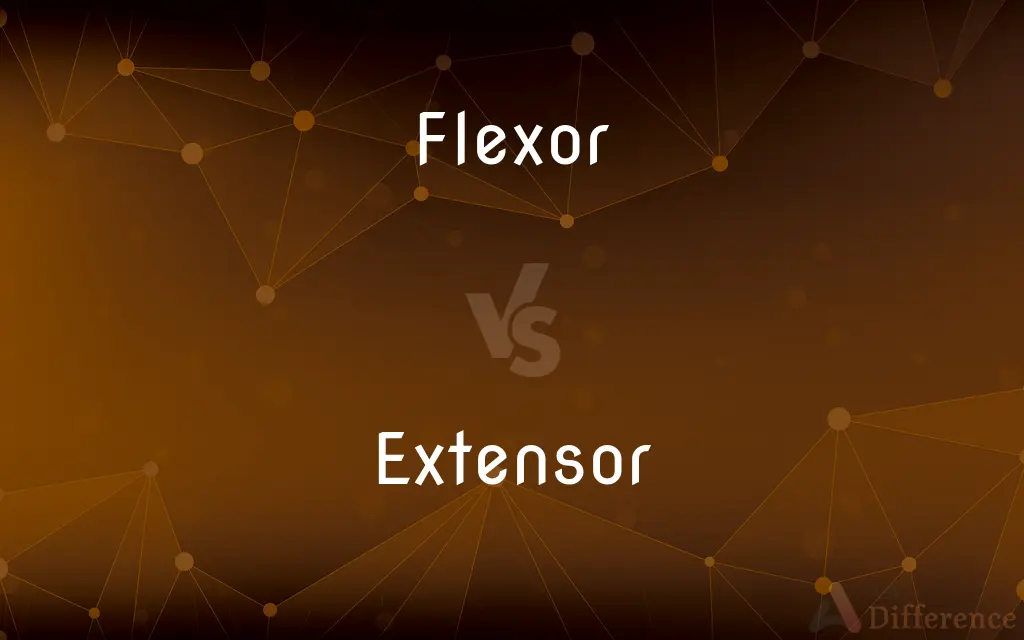Flexor vs. Extensor — What's the Difference?
By Fiza Rafique & Maham Liaqat — Updated on April 22, 2024
Flexor muscles contract to bend a joint, decreasing the angle between two bones; extensor muscles contract to straighten a joint, increasing the angle.

Difference Between Flexor and Extensor
Table of Contents
ADVERTISEMENT
Key Differences
Flexor muscles are specialized to facilitate bending motions at joints, pulling bones closer together, whereas extensor muscles are designed to extend or straighten joints, pushing bones apart. For example, the biceps are a well-known flexor muscle that contracts to bend the elbow, while the triceps are extensor muscles that work to straighten the elbow.
Flexors often work in opposition to extensors, maintaining balance and control of movements; on the other hand, extensors provide the necessary force to open or extend joints.
In anatomical terms, flexors are typically located on the anterior (front) part of the body, whereas extensors are located on the posterior (back) part. This arrangement allows for coordinated and smooth movements.
Flexor and extensor muscles are essential in nearly all voluntary movements, especially in limbs; for example, flexors enable gripping and holding, while extensors allow for releasing and pushing actions.
Comparison Chart
Function
Contracts to bend a joint
Contracts to extend or straighten a joint
ADVERTISEMENT
Example Muscles
Biceps (arm), Hamstrings (leg)
Triceps (arm), Quadriceps (leg)
Common Action
Decreasing the angle between bones
Increasing the angle between bones
Anatomical Location
Generally anterior (front) of the body
Generally posterior (back) of the body
Role in Movement
Facilitates gripping, walking, bending
Facilitates releasing, walking, straightening
Compare with Definitions
Flexor
Muscle that bends a joint.
The flexor muscles in your forearm help you bend your wrist.
Extensor
Muscle that straightens a joint.
Extensor muscles in the legs straighten the knee to stand up.
Flexor
Located mostly in front.
Flexor muscles are prominent on the anterior sides of the body.
Extensor
Active in walking.
The quadriceps, an important extensor group, help in leg extension during walking.
Flexor
Responsible for contraction.
Flexor muscles contract to pull bones closer and decrease joint angles.
Extensor
Responsible for extending.
Extensor muscles extend the joint, increasing the distance between bones.
Flexor
Active in walking.
The hamstring, a key flexor, is vital for bending the knee while walking.
Extensor
Essential in releasing.
Extensor muscles in the fingers help in releasing grasped objects.
Flexor
Essential in gripping.
Flexor muscles in the hands are critical for holding objects.
Extensor
Located mostly in back.
Extensor muscles are primarily found on the posterior of the body.
Flexor
A muscle that when contracted acts to bend a joint or limb in the body.
Extensor
A muscle that extends or straightens a limb or body part.
Flexor
A muscle whose contraction acts to bend a joint or limb.
Extensor
(anatomy) A muscle whose contraction extends or straightens a limb or body part.
Flexor
A muscle which bends or flexes any part; as, the flexors of the arm or the hand; - opposed to extensor.
Extensor
A muscle which serves to extend or straighten any part of the body, as an arm or a finger; - opposed to flexor.
Flexor
A skeletal muscle whose contraction bends a joint
Extensor
A skeletal muscle whose contraction extends or stretches a body part
Common Curiosities
What is a flexor muscle?
A flexor muscle is one that contracts to bend a joint, decreasing the angle between the involved bones.
Can flexors and extensors be found in all parts of the body?
Yes, flexors and extensors are found throughout the body, particularly in limbs where they facilitate complex movements.
How do flexor and extensor muscles work together?
Flexor and extensor muscles work antagonistically to control the movement of joints, ensuring balanced and smooth motion.
What is an extensor muscle?
An extensor muscle is one that contracts to straighten a joint, increasing the angle between the involved bones.
Can injury to a flexor muscle affect joint movement?
Yes, injuries to flexor muscles can severely restrict the ability to bend joints, impacting daily activities.
What happens if flexor muscles are stronger than extensors, or vice versa?
Imbalance between flexor and extensor muscles can lead to joint instability, posture problems, or movement inefficiencies.
Are there exercises that specifically strengthen flexor muscles?
Yes, exercises like wrist curls and hamstring curls specifically target and strengthen flexor muscles.
What exercises strengthen extensor muscles?
Exercises like leg extensions and pushdowns are effective in strengthening extensor muscles.
How does aging affect flexor and extensor muscles?
Aging can lead to a decrease in muscle mass and strength, affecting both flexors and extensors, potentially impacting mobility and balance.
What role do extensor muscles play in posture?
Extensor muscles are crucial for maintaining upright posture and alignment, particularly in the spine and legs.
Share Your Discovery

Previous Comparison
Ignostic vs. Atheist
Next Comparison
Wife vs. WiveAuthor Spotlight
Written by
Fiza RafiqueFiza Rafique is a skilled content writer at AskDifference.com, where she meticulously refines and enhances written pieces. Drawing from her vast editorial expertise, Fiza ensures clarity, accuracy, and precision in every article. Passionate about language, she continually seeks to elevate the quality of content for readers worldwide.
Co-written by
Maham Liaqat















































